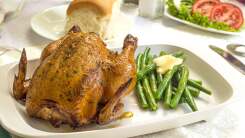The Right Way to Take a (Wild) Leek
It is ramp season, the season that propels even the most calm and reasonable eaters into a slight panic. Do not get me wrong; ramps are delicious—I like wrapping the broad, garlicky leaves around scallops—but over-enthusiastic and thoughtless foraging can lead to the wild leek being depleted, leaving fewer ramps for us to find and enjoy each year.
But there is a right way to harvest these wild-growing alliums—or take a leek, if you will—and you should learn how to do it before you set off into the forest.
What is a ramp?
But before we get into how to gather these tasty spring vegetables, let’s review what they are, exactly:

These thin, delicate little guys look like small leeks and have broad, green leaves. Ramps are shady subjects, and are foraged from dark, wooded areas. Their pungent, garlicky, oniony flavor and short season (generally late April to early June) make them
very
popular, but you should be able to find them at your local farmer’s market or fancy pants grocery stores like Whole Foods.
There are two types of ramps—Allium tricoccum var. tricoccum, which have wider leaves and red stems, and Allium tricoccum var. burdickii, which have a more narrow leaf and white stem, and are milder in flavor. As this article from the foraging blog wildedible.com explains, you need to be sure the broad-leafed plant you’re harvesting actually smells like garlic, as there are some toxic lookalikes out there (when in doubt, consult a seasoned forager).
How to harvest a ramp
According wildedible, the most sustainable way to harvest a ramp is to take a single leaf, leaving secondary leaves and root intact, so that they can continue to function as a source of rampy goodness for years to come. If you simply must have the bulb, don’t get greedy and pull the whole thing out:
If you insist on taking bulbs, please dig sustainably with a knife: Simply insert your knife into the dirt at an angle and slice off a third or so of the root, leaving it in the ground to re-grow. Then pull the rest of the plant out by its stems.
It will take a little practice to get a feel for where to put the knife. You can also gently pull back the dirt from around the bulb so you can see where you’re cutting. If you do this, make sure to pull back just enough dirt to expose a little bit of the bulb and re-cover the roots after cutting.
You should also make sure your knife is sharp—take a little sharpening stone with you if you plan to do a lot of ramping—as a dull knife can damage the plant. Allow yourself plenty of time so you don’t feel rushed, and don’t take more than you can eat in a few days. Ramps are delicious, but the smell of rotten ramps is uniquely disgusting, as is wasting such a prized vegetable.
RECOMMENDED NEWS

How to Air Fry a Succulent Cornish Hen
When I was six, my mom moved from Mississippi to Los Angeles with me and my sisters, and I discovere...

The Best Pumpkin Spice Item Is the Scone, You Fools
Fall is here, which means a deluge of questionable pumpkin spice items, along with some dubious opin...

Use More White Balsamic Vinegar
You’re probably familiar with balsamic vinegar—that sophisticated, inky bottle coyly sitting in the ...

The Two Best Things to Do With Leftover Cranberry Sauce
I fully planned on buying a turkey breast for my downsized Thanksgiving this year, yet when it came ...

The First 5 Things You Should Sous Vide With Your New Immersion Circulator
If you have recently purchased an immersion circulator—or are looking to—deciding what to cook first...

Chocolate Is a Chip Dip
I think I could subsist on a diet made entirely of dips. Yogurt dip for breakfast, beet dip for lunc...
Comments on "The Right Way to Take a (Wild) Leek" :